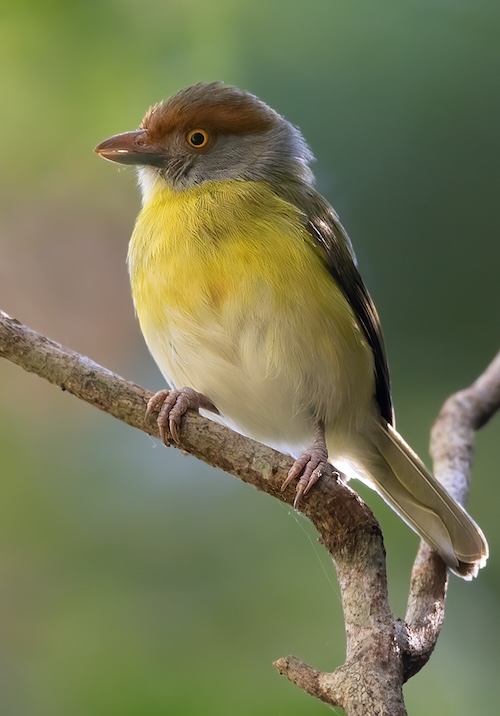Vireonidae – Vireos, Greenlets & Shrike-babblers
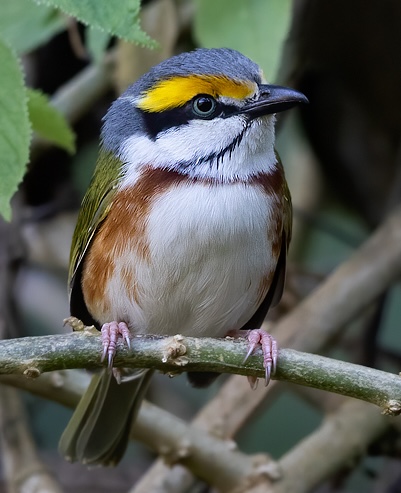
The Vireonidae (Vireos, Greenlets and others) make up a family of small to medium-sized passerines restricted to the New World – until recent DNA studies show two genera in the Old-World. ‘Vireo’ is a Latin word referring to a green migratory bird, perhaps the female Golden Oriole, possibly the European Greenfinch.
Traditionally the family was considered to include four New World genera containing the Vireo (true vireos), Hylophilus (Greenlets), Vireolanius (Shrike-vireos) and Cyclarhis (Peppershrikes). However, phylogenetic studies found Hylophilus to be polyphyletic, with the greenlets split into three distinct groups: the ‘scrub’ greenlets in a restricted Hylophilus, the ‘canopy’ greenlets in resurrected genus Pachysylvia and the tawny-crowned greenlet in new genus Tunchiornis.
|
|
|
|
Bell’s Vireo Vireo bellii |
Rufous-browed Peppershrike Cyclarhis gujanensis |
|
All photos on this page courtesy of ©Dubi Shapiro |
|
In addition, biochemical studies have identified two babbler genera (Pteruthius and Erpornis) which may be Old World members of this family. Observers have commented on the vireo-like behaviour of the Pteruthius shrike-babblers, but apparently no-one suspected the bio-geographically unlikely possibility of vireo relatives in Asia. Some recent taxonomic treatments, such as the IOC taxonomy and combined AviList followed here, include Pteruthius and Erpornis in Vireionidae, whereas other place them in their own families Pteruthidae and Erpornidae.
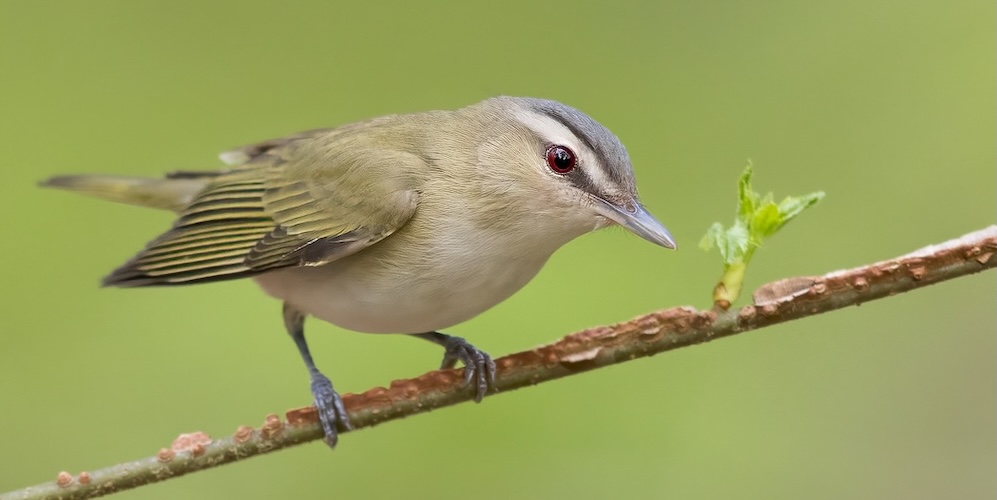
Red-eyed Vireo Vireo olivaceus
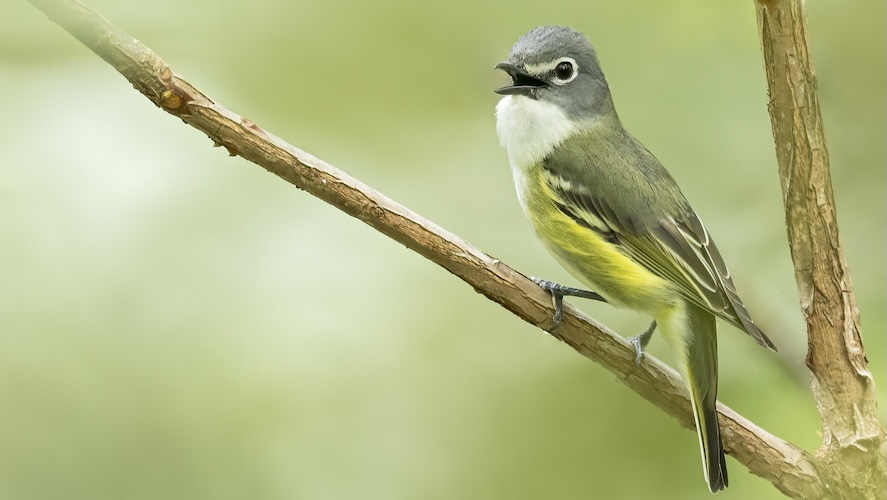
Blue-headed Vireo Vireo solitarius
They are typically dull-plumaged and greenish in colour, the smaller species resembling wood warblers apart from their heavier bills. They range in size from the Chocó Vireo, Dwarf Vireo and Lesser Greenlet, all at around ten centimetres and eight grams, to the peppershrikes and shrike-vireos at up to seventeen centimetres and forty grams.
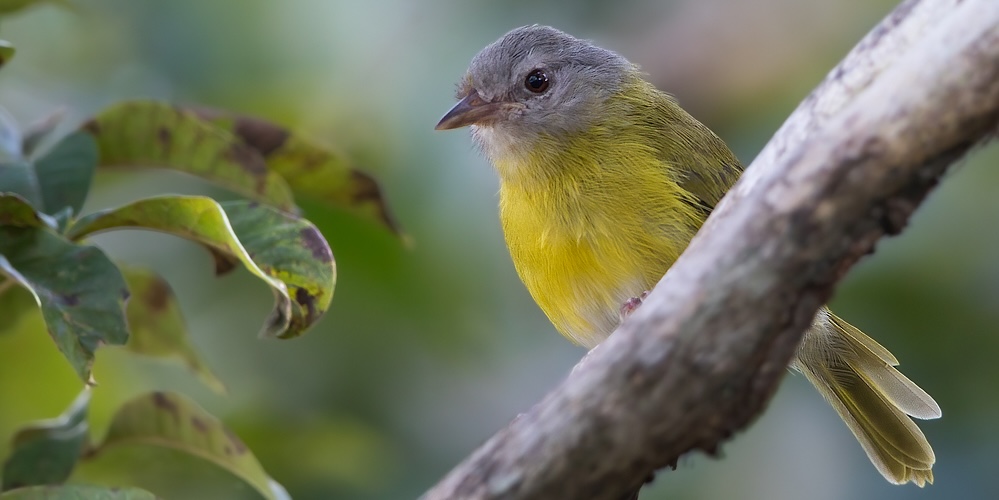
Ashy-headed Greenlet Hylophilus pectoralis
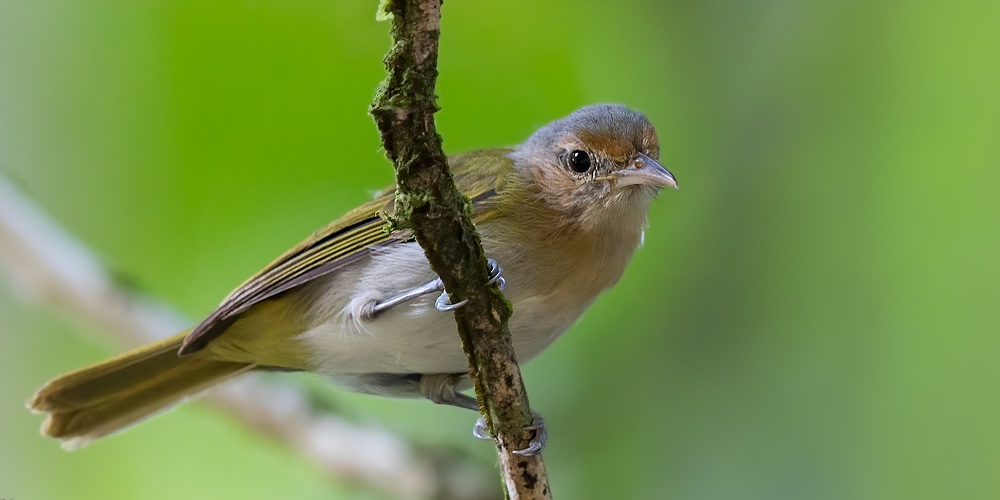
Buff-cheeked Greenlet Pachysylvia muscicapina
Males of most species are persistent singers. Songs are usually rather simple, monotonous in some species of the Caribbean littoral and islands, and most elaborate and pleasant to human ears in the Chocó vireo and the peppershrikes.
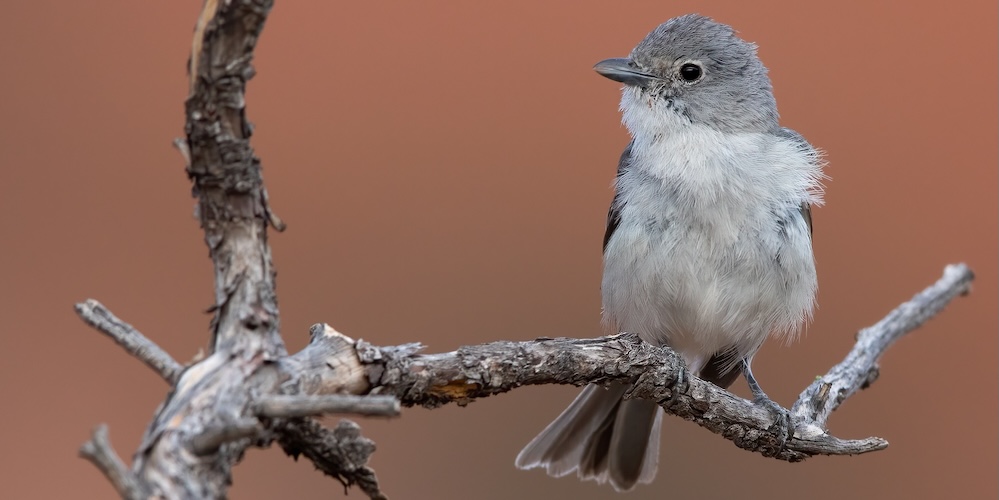
Grey Vireo Vireo vicinior
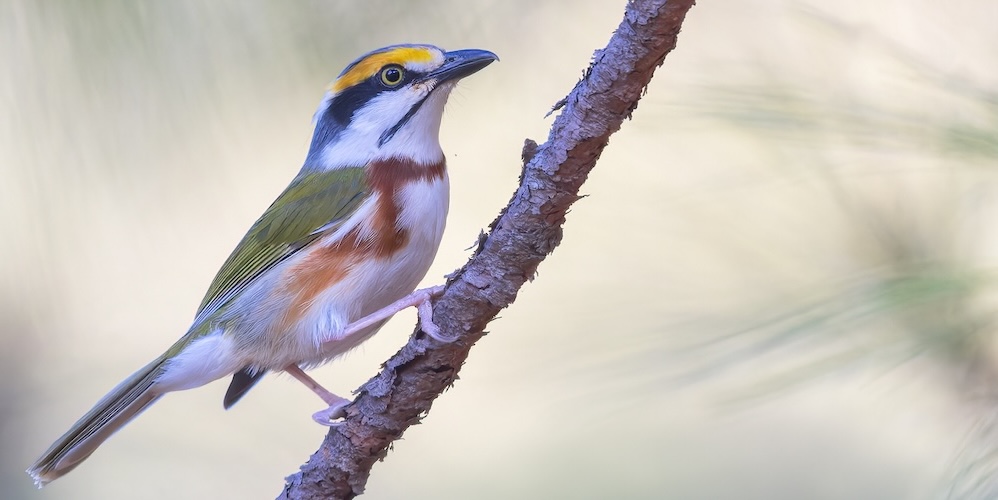
Chestnut-sided Shrike-Vireo Vireolanius melitophrys
Most species are found in Middle America and northern South America. Thirteen species of true vireos occur farther north, in the United States, Bermuda and Canada; of these all but Hutton’s Vireo are migratory. Members of the family seldom fly long distances except in migration. A few species in the genus Vireo have appeared on the eastern side of the Atlantic as vagrants to the Western Palearctic, the most frequent being Red-eyed Vireo. They inhabit forest environments, with different species preferring forest canopies, undergrowth, or mangrove swamps.
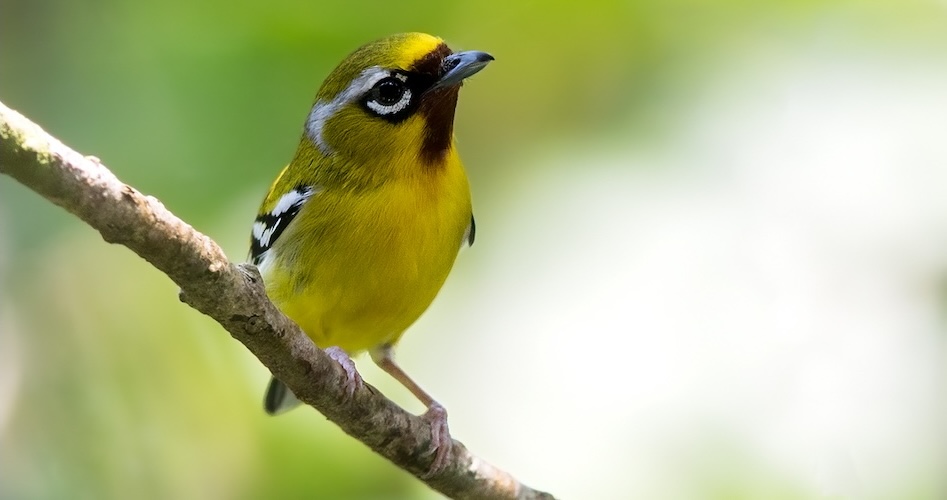
Clicking Shrike-babbler Pteruthius intermedius
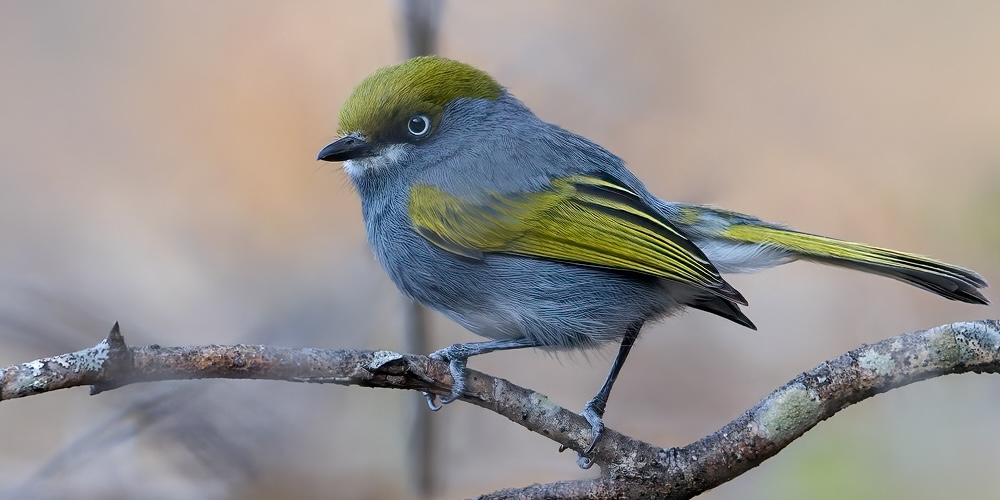
Slaty Vireo Vireo brevipennis
The resident species occur in pairs or family groups that maintain territories all year (except Hutton’s Vireo, which joins mixed feeding flocks). Most of the migrants defend winter territories against conspecifics. The exceptions are the complex comprising the Red-eyed Vireo, the Yellow-green Vireo, the Black-whiskered Vireo, and the Yucatan Vireo, which winter in small wandering flocks.
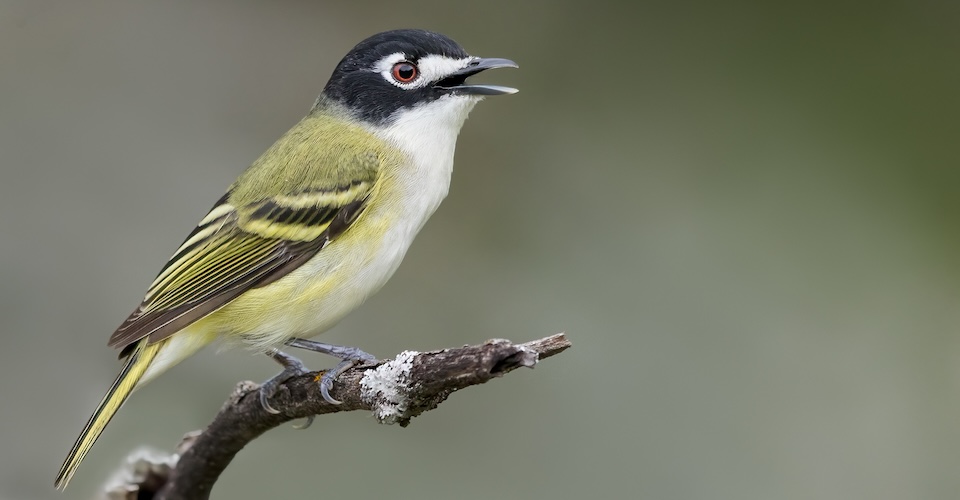
Black-capped Vireo Vireo atricapilla

Golden Vireo Vireo hypochryseus
The nests of many tropical species are unknown. Of those that are known, all build a cup-shaped nest that hangs from branches. The female does most of the incubation, spelled by the male except in the Red-eyed Vireo complex.
All members of the family eat some fruit, but mostly consume insects and other arthropods. They take prey from leaves and branches; true vireos also catch insects in flight, and the Grey Vireo takes around five percent of its prey from the ground.
-
Number of bird species: 64
(As at October 2025)
According to the recently (2025) amalgamated AviList, there are sixty-four species, in eight genera in the Vireonidae family. They are:
Black-headed Shrike-babbler Pteruthius rufiventer
Pied Shrike-babbler Pteruthius flaviscapis
Blyth’s Shrike-babbler Pteruthius aeralatus
Green Shrike-babbler Pteruthius xanthochlorus
Black-eared Shrike-babbler Pteruthius melanotis
Trilling Shrike-babbler Pteruthius aenobarbus
Clicking Shrike-babbler Pteruthius intermedius
White-bellied Erpornis Erpornis zantholeuca
Black-billed Peppershrike Cyclarhis nigrirostris
Rufous-browed Peppershrike Cyclarhis gujanensis
Grey-eyed Greenlet Hylophilus amaurocephalus
Rufous-crowned Greenlet Hylophilus poicilotis
Olivaceous Greenlet Hylophilus olivaceus
Ashy-headed Greenlet Hylophilus pectoralis
Scrub Greenlet Hylophilus flavipes
Grey-chested Greenlet Hylophilus semicinereus
Brown-headed Greenlet Hylophilus brunneiceps
Lemon-chested Greenlet Hylophilus thoracicus
Chestnut-sided Shrike-Vireo Vireolanius melitophrys
Green Shrike-Vireo Vireolanius pulchellus
Yellow-browed Shrike-Vireo Vireolanius eximius
Slaty-capped Shrike-Vireo Vireolanius leucotis
Tawny-crowned Greenlet Tunchiornis ochraceiceps
Rufous-fronted Greenlet Tunchiornis ferrugineifrons
Guianan Greenlet Tunchiornis luteifrons
Para Greenlet Tunchiornis rubrifrons
Lesser Greenlet Pachysylvia decurtata
Dusky-capped Greenlet Pachysylvia hypoxantha
Buff-cheeked Greenlet Pachysylvia muscicapina
Golden-fronted Greenlet Pachysylvia aurantiifrons
Rufous-naped Greenlet Pachysylvia semibrunnea
Golden Vireo Vireo hypochryseus
Tepui Vireo Vireo sclateri
Philadelphia Vireo Vireo philadelphicus
Warbling Vireo Vireo gilvus
Brown-capped Vireo Vireo leucophrys
Yellow-green Vireo Vireo flavoviridis
Red-eyed Vireo Vireo olivaceus
Yucatan Vireo Vireo magister
Black-whiskered Vireo Vireo altiloquus
Noronha Vireo Vireo gracilirostris
Chivi Vireo Vireo chivi
Grey Vireo Vireo vicinior
Hutton’s Vireo Vireo huttoni
Yellow-throated Vireo Vireo flavifrons
Yellow-winged Vireo Vireo carmioli
Choco Vireo Vireo masteri
Blue-headed Vireo Vireo solitarius
Cassin’s Vireo Vireo cassinii
Plumbeous Vireo Vireo plumbeus
Blue Mountain Vireo Vireo osburni
Flat-billed Vireo Vireo nanus
Mangrove Vireo Vireo pallens
Cozumel Vireo Vireo bairdi
Thick-billed Vireo Vireo crassirostris
Cuban Vireo Vireo gundlachii
White-eyed Vireo Vireo griseus
San Andres Vireo Vireo caribaeus
Jamaican Vireo Vireo modestus
Bell’s Vireo Vireo bellii
Puerto Rican Vireo Vireo latimeri
Slaty Vireo Vireo brevipennis
Black-capped Vireo Vireo atricapilla
Dwarf Vireo Vireo nelsoni
-
Vireonidae
Family AccountThese are all small, big-billed, arboreal birds of woodlands and forests, with many of the North American species known for their indefatigable all-day singing. -
Vireonidae
Family AccountThe vireos /ˈvɪrioʊz/ make up a family, Vireonidae, of small to medium-sized passerine birds found in the New World and Southeast Asia.
Given the number of species in this family, Fatbirder does not provide quick links to all of them. However, the entries below do include links to representatives of every genera, all those illustrated and some of the most often encountered, iconic or sought-after species.
-
Ashy-headed Greenlet Hylophilus pectoralis
Species AccountSmall vireo-like bird found in variety of lightly wooded habitats from forest edges and scrub to gardens where it can be quite common... -
Ashy-headed Greenlet Hylophilus pectoralis
Species AccountSound archive and distribution map -
Bell's Vireo (Least Vireo) bellii pusillus
Species AccountThe Least Bell's Vireo, Vireo bellii pusillus, is one of four subspecies of Bell's Vireo recognized by the American Ornithologist's Union (AOU 1957). It is the western-most subspecies, breeding entirely within California and northern Baja California. A second subspecies, V. bellii arizonae, has a limited distribution in California along the lower Colorado River, but occurs primarily throughout Arizona, Utah, Nevada, and Sonora, Mexico. The subspecies are believed to be isolated from one another during both the breeding and wintering seasons (Hamilton 1962).… -
Bell's Vireo (Least Vireo) bellii pusillus
Species AccountA fairly drab vireo of dense, scrubby vegetation, often near water. Two populations: Eastern birds are brighter, with yellow flanks and olive-green back. -
Bell's Vireo (Least Vireo) bellii pusillus
Species AccountSound archive and distribution map. -
Black-capped Vireo Vireo atricapilla
Species AccountThe black-capped vireo (Vireo atricapilla) is a small bird native to the United States and Mexico. -
Black-capped Vireo Vireo atricapilla
Species AccountSound archive and distribution map -
Blue-headed Vireo Vireo solitarius
Species AccountSound archive and distribution map. -
Blue-headed Vireo Vireo solitarius
Species AccountWinters from the southeastern U.S. to Central America. Blue-headed is the brightest of the "Solitary Vireo" complex, and usually identifiable by range alone. -
Buff-cheeked Greenlet Pachysylvia muscicapina
Species AccountThe buff-cheeked greenlet (Pachysylvia muscicapina) is a species of bird in the family Vireonidae. It is found in Bolivia, Brazil, French Guiana, Guyana... -
Buff-cheeked Greenlet Pachysylvia muscicapina
Species AccountSound archive and distribution map -
Chestnut-sided Shrike-Vireo Vireolanius melitophrys
Species AccountSpectacular, large vireo of highland forests, especially pine-oak. Like most vireos, rather sluggish and easily overlooked. -
Chestnut-sided Shrike-Vireo Vireolanius melitophrys
Species AccountSound archive and distribution map -
Clicking Shrike-babbler Pteruthius intermedius
Species AccountThe clicking shrike-babbler (Pteruthius intermedius) is a species of bird in the family Vireonidae. -
Clicking Shrike-babbler Pteruthius intermedius
Species AccountSound archive and distribution map -
Golden Vireo Vireo hypochryseus
Species AccountSmall, rather chunky but long-tailed bird of tropical forest and woodland in lowlands and foothills; endemic to western Mexico. -
Golden Vireo Vireo hypochryseus
Species AccountSound archive and distribution map -
Grey Vireo Vireo vicinior
Species AccountThe gray vireo (Vireo vicinior) is a small North American passerine bird. -
Grey Vireo Vireo vicinior
Species AccountSound archive and distribution map -
Hutton's Vireo Vireo huttoni
Species AccountA winter field identification problem in western North America (B.C. to California, west of the Cascades & Sierra Nevada) is separating Hutton's Vireo Vireo huttoni from Ruby-crowned Kinglet Regulus calendula. -
Hutton's Vireo Vireo huttoni
Species AccountHutton's vireo (Vireo huttoni) is a small songbird. It is approximately 5 inches (12–13 cm) in length, dull olive-gray above and below. -
Hutton's Vireo Vireo huttoni
Species AccountSound archive and distribution map. -
Red-eyed Vireo Vireo olivaceus
Species AccountThe red-eyed vireo (Vireo olivaceus) is a small American songbird. It is somewhat warbler-like but not closely related to the New World warblers (Parulidae). Common across its vast range, this species is not considered threatened by the IUCN. -
Red-eyed Vireo Vireo olivaceus
Species AccountSound archive and distribution map -
Rufous-browed Peppershrike Cyclarhis gujanensis
Species AccountThe rufous-browed peppershrike (Cyclarhis gujanensis) is a passerine bird in the vireo family. -
Rufous-browed Peppershrike Cyclarhis gujanensis
Species AccountSound archive and distribution map. -
Slaty Vireo Vireo brevipennis
Species AccountSlaty Vireo Vireo brevipennis Moves sluggishly, holding its tail cocked and making short sallies for fruit and insects. -
Slaty Vireo Vireo brevipennis
Species AccountSound archive and distribution map -
Tawny-crowned Greenlet Tunchiornis ochraceiceps
Species AccountThe tawny-crowned greenlet (Tunchiornis ochraceiceps) is a species of bird in the family Vireonidae and is the only species... -
Tawny-crowned Greenlet Tunchiornis ochraceiceps
Species AccountSound archive and distribution map -
Warbling Vireo Vireo gilvus
Species AccountThe warbling vireo (Vireo gilvus) is a small North American songbird. Warbling vireo. Adult male singing in New York. Conservation status. -
Warbling Vireo Vireo gilvus
Species AccountSound archive and distribution map -
White-bellied Erpornis Erpornis zantholeuca
Species AccountSmall, crested, yuhina-like bird, frequently seen as a part of mixed flocks in a wide range of forested habitats. -
White-bellied Erpornis Erpornis zantholeuca
Species AccountSound archive and distribution map


